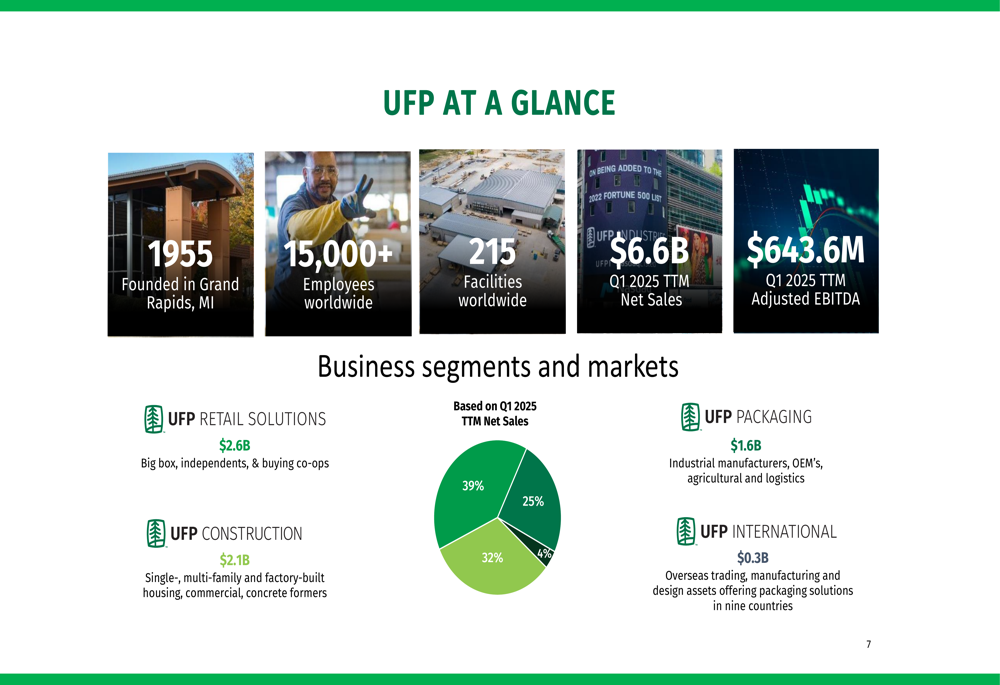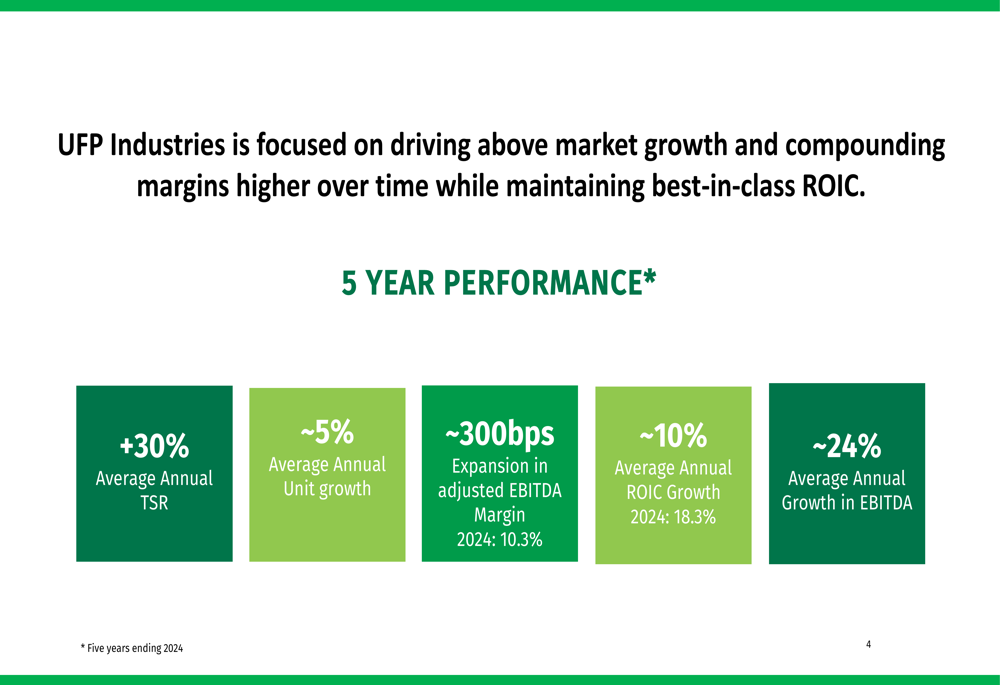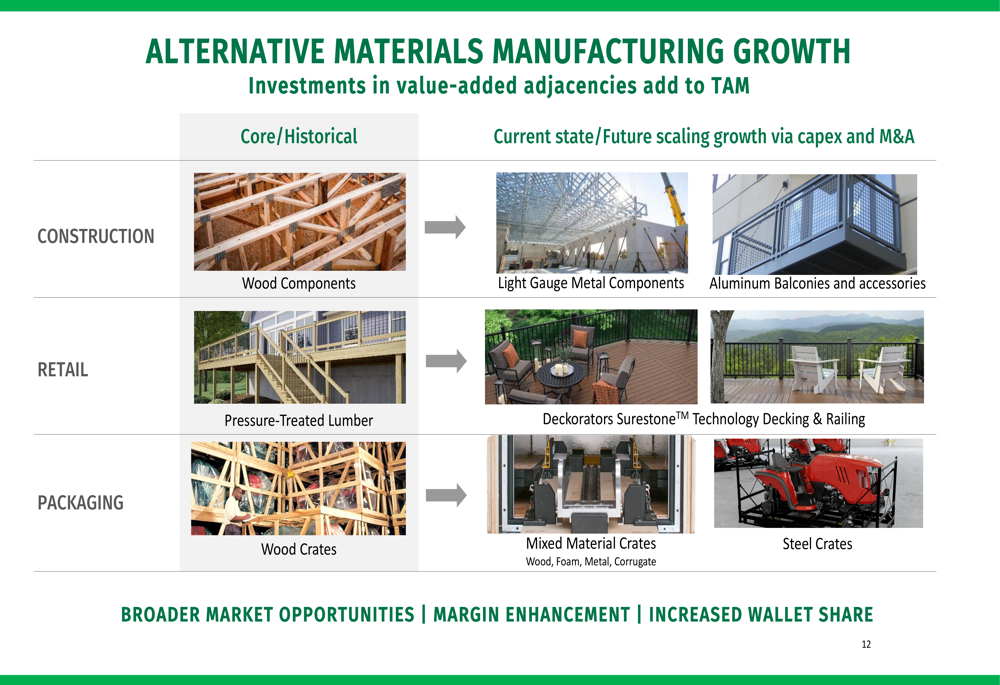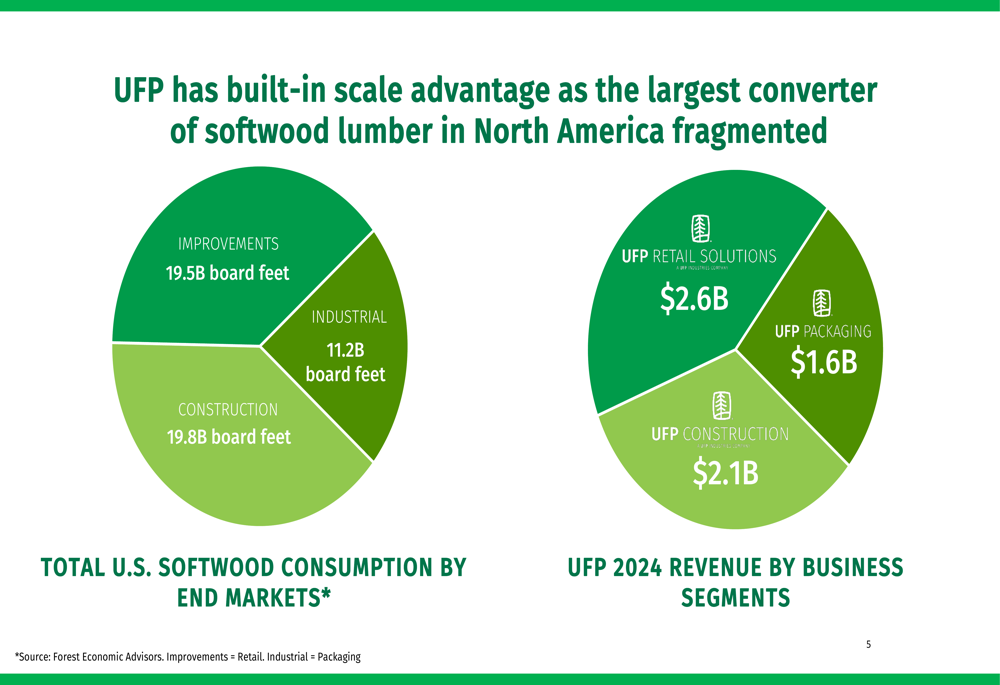Gold prices hold gains amid Fed rate cut hopes, tariff jitters
Introduction & Market Context
UFP Industries Inc. (NASDAQ:UFPI) recently presented its investor relations slides covering performance through March 29, 2025, highlighting the company’s strategic positioning and long-term vision amid challenging market conditions. As a major converter of approximately 7% of North American softwood lumber, UFP operates through three main segments: UFP Retail Solutions, UFP Construction, and UFP Packaging (NYSE:PKG), generating $6.6 billion in trailing twelve-month sales.
The presentation comes at a time when the company faces headwinds, with Q1 2025 results showing a 3% decline in sales to $1.6 billion and a 21% drop in adjusted EBITDA to $142 million. Despite these challenges, UFP managed to beat earnings expectations with an EPS of $1.60, slightly above the forecast of $1.57, though revenue narrowly missed projections.
Executive Summary
UFP Industries has positioned itself as a diversified manufacturer of value-added products across multiple end markets. The company’s global footprint now spans 215 facilities across 8 countries, with the majority (189) located in the United States. This extensive network supports UFP’s strategy of diversification and scale as competitive advantages.
As shown in the following snapshot of the company’s operations and financial performance:

The company’s 5-year performance through 2024 demonstrates strong historical growth, with an average annual total shareholder return of 30% and average annual EBITDA growth of approximately 24%. However, recent quarterly results suggest the company is navigating more challenging market conditions in 2025.
The following chart illustrates UFP’s impressive 5-year performance metrics:

Strategic Initiatives
At the core of UFP’s strategy is a continued shift toward value-added products, which has been a key driver of margin improvement over the past decade. The company has successfully increased its value-added sales from 41% of total sales in 2011 to 70% in Q1 2025, contributing to EBITDA margin expansion from 3% to 9.7% over the same period.
This strategic evolution is clearly demonstrated in the following chart showing the growth of value-added sales:

UFP is also expanding beyond traditional wood products into alternative materials, increasing its total addressable market. The company has evolved from basic wood components to more sophisticated offerings like light gauge metal components and aluminum balconies in construction, Deckorators Surestone Technology in retail, and mixed material and steel crates in packaging.
The following image illustrates this product evolution across business segments:

CEO Will Schwartz emphasized the company’s resilience during the recent earnings call, stating, "Despite ongoing market volatility, our go-forward strategy remains unchanged." This commitment to strategic continuity comes despite the current challenging environment, where UFP anticipates continued demand challenges across all segments and competitive pricing pressures.
Detailed Financial Analysis
UFP’s business is divided into three main segments, with UFP Retail Solutions contributing $2.6 billion in sales, UFP Construction $2.1 billion, and UFP Packaging $1.6 billion. The company’s international operations account for approximately $0.3 billion in sales.
The following chart breaks down UFP’s market position and revenue by segment:

While the company’s long-term financial performance has been strong, recent results reveal some challenges. The Q1 2025 adjusted EBITDA margin contracted to 8.9%, down from the 10.3% reported for full-year 2024. Operating cash flow was negative at $109 million, partly due to share repurchases totaling $70 million.
Despite these short-term challenges, UFP maintains a strong financial foundation. According to recent financial data, the company has more cash than debt on its balance sheet and liquid assets exceeding short-term obligations, with a current ratio of 4.88 indicating excellent liquidity. The company also maintains a robust return on invested capital of 15.5%.
Forward-Looking Statements
UFP Industries has outlined ambitious long-term financial goals, though the recent earnings report suggests these targets have been pushed out due to economic uncertainties. The company aims for:
- Annual unit sales growth of 7-10% including small acquisitions
- New product sales representing 10% of total sales
- Achieving and sustaining a 12.5% adjusted EBITDA margin
- Earning an incremental return on new investment greater than the 15% hurdle rate
- Maintaining a conservative capital structure below 1.5X Adjusted EBITDA
These goals are visually presented in the following slide:

The company’s business model and competitive advantages are built around five key elements: Scale through Diversification, Incentives Aligned With Shareholders, Commitment to Innovation, Culture, and Structure. UFP believes these elements provide sustainable competitive advantages in the marketplace.
The following slide details these competitive advantages:

Looking ahead, UFP faces several challenges, including macroeconomic uncertainty, revenue shortfalls, competitive pricing pressures, potential changes in lumber tariffs, and weakness in the housing market. However, the company’s strategy of targeting market share gains to offset demand declines and focusing on innovation may help navigate these headwinds.
CFO Mike Cole noted during the earnings call, "We will continue to focus on what is under our control to manage through these more challenging conditions." This pragmatic approach, combined with the company’s diversified business model and strong balance sheet, positions UFP to weather current market volatility while pursuing its long-term strategic objectives.
Full presentation:
This article was generated with the support of AI and reviewed by an editor. For more information see our T&C.
